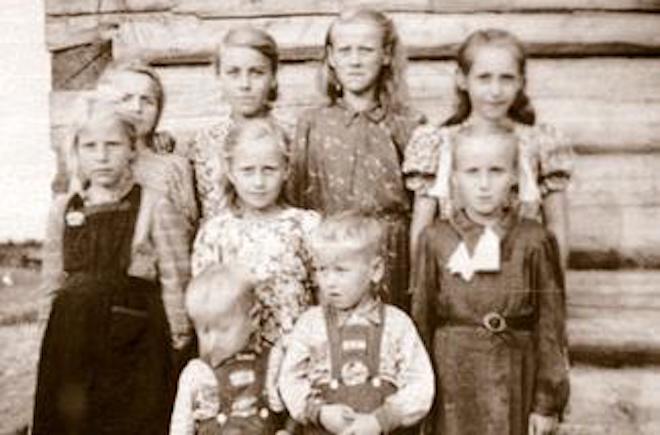The experience of terror and deportation under the first Soviet occupation in 1940-1941 caused massive escape (approximately 80,000) to the West during August and September 1944, just before the second Soviet occupation. A second wave of deportations took place across the Baltic states in March 1949, when approximately 90,000 people, including more than 20,000 Estonians, were sent to Siberia. Through these waves of deportations, the number of Estonian population shrunk around by 10%. The victims of repressions included politicians, municipality employees, civil servants, police officers and military staff, entrepreneurs and more successful farmers, intellectuals and their families.
Madli, 70, is the daughter of the survivor of mass deportations from Estonia, whose mother, Salme Vitismann, was saved by kind neighbors from the Soviet soldiers who came after her at March 25th night, 1949 in the center of Tallinn. Madli recalls that by that time her mother was 29 years old and was living in a 9 square meter room on the second floor flat of the house located in central Tallinn. She was sharing the flat with Henriette Härm, a 63 years old widow whom she called Aunt Härmi.
“I told my son, Mart, that we both would not be here now, if the neighbors had not saved my mom from the deportation to Siberia,” Madli noted. According to her, she had heard this story from her mother and Henriette Härm many times and she often thinks how people lived in constant fear during those repression years.
Madli knows from her mother that everyone was very fearful and stressed those times. No one could sleep calmly at night and they used to wake up even due to a slight noise.
“That night a truck stopped in front of the house of my mother and she immediately woke up. She realized the soldiers came after her. She woke Aunt Härmi up and ran upstairs, to the attic while the widow was trying to hide her clothes. The attic key used to hang in the second floor toilet, so the Aunt Härmi took it and locked my mother in the attic from the outside. The soldiers had to wake the landlord up from outside of the house as there were buttons for door bells there, the first step to get inside the house. While he woke up, dressed and opened the main door, the hiding operation of my mom on the second floor took place.”
Madli remembers that the landlord’s name was Johannes Perker and by the time of the deportation night he was 50-60 years old. The soldiers started to ask for Salme but the widow told them she was not at home. The soldiers searched the house and went up to the attic door. They wanted to see what was inside. According to Madli, Johannes realized that Salme was hiding there but he told the soldiers there was nothing inside. When asked to open it, the landlord agreed but asked some time to go downstairs and find the key. The soldiers thought that if the attic was closed and the key was downstairs, there was nobody there and left without searching it.
“My mother was working for the Academy of Science then, with other Estonians, grown up in the prewar Estonia. She went to her chief, told him what happened, adding she needed to leave the city immediately. She was given fictitious vacation document to Tartu but in real she went near Tallinn to her uncle and was hiding there for a while. The soldiers once again went to her flat in Tallinn at midday but saw she was not there and they never showed up again. As we learned later, the soldiers were gathering people during that operation for four days. My mother told me that her two brothers Julius Velland and Johannes Vitismann were in the German army, in order not to let Red army enter Estonia. The first one managed to run away and escaped to the United States and the latter was arrested in 1947 and sent to a prison camp somewhere in Arkhangelsk. After the war he managed to go to the US and joined his brother there. Their sister, Julie, 43, was deported the same night on March 25th, 1949, when the soldiers came after my mom as well. My grandfather “was lucky to die” before deportations, in January 1949, as my mother would put it, otherwise he would have died in a deportation train, as he was a 79-year-old sick man.”
Madli explains that her mother was the youngest one in her family and she was left all alone in the country after that operation.
“I think it was the reason she decided to have a child. I was born 1.5 years later.” According to her, if her mother did not manage to survive the deportation operation, she would not have been able to send food and parcels to her brothers in the camp and to her sister in Siberia, which saved their lives.
After Stalin’s death in 1953, Madli’s aunt was allowed to leave Siberia in autumn 1956 but she could not immediately return to Estonia, as she had no money to buy a train ticket.
“It was so weird. A free person could not come back home because she had no money, so my mother sent her some money for the ticket. Those times no one had money in Siberia. If people needed some food or products, they were growing them or exchanging what they had with the others. As I have read in the letters of my aunt to my mother, it was in November 1956 when she took a train and came to our place. I was six then. Julie was sleeping in the room of Aunt Härmi because our room was only 9 square meters, as I said and no one gave her back her own flat where she lived before the deportation. Few years after, when my mom got a flat through her work, my aunt moved to our small room.”
1949 deportation operation, called “Priboi” (Coastal Surf) was planned by Soviet Security officials for three months and it aimed at deportation, intimidation and Sovietization of the residents of Baltic States. The Secret Service gathered all information about the people that were aimed, mainly dividing them into three groups. The first group were “kulaks” who were peasants wealthy enough to own a farm and hire labor. Madli’s grandfather was included in this category. The second group were Forest Brothers, partisans who waged guerrilla warfare against Soviet rule during the Soviet invasion and occupation of the Baltic states and the third group were so called “nationalists” involved in some movements. As a result of the “Priboi” operation, 20,713 people were deported from Estonia and in total, 94,779 people were deported from Lithuania, Latvia and Estonia. Over 70% of the deportees were women and children under the age of 16.
By Tea Mariamidze




